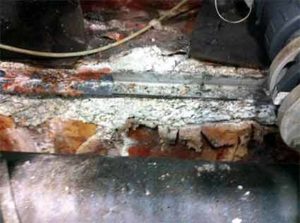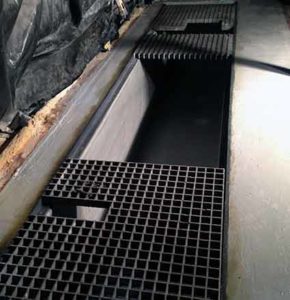†Revitalizing Concrete Trench Drains: A Long-Lasting Fix Concrete trench drains are essential in managing water runoff and protecting critical infrastructure like utility lines and chemical containment systems. These structures are especially vital in industrial environments where even minor failures can lead to major disruptions. However, over time, concrete trenches are prone to deterioration due to a variety of factors—fire, aggregate expansion, seawater exposure, bacterial activity, calcium leaching, physical damage, and chemical attacks such as carbonation, chlorides, sulfates, and distilled water. This degradation weakens the structure, leading to leaks, loss of strength, and costly repairs or replacements. Take, for example, a battery distribution plant that faced serious issues with its concrete trenches. Despite being less than 10 years old, the facility had been protected by a novolac coating. Unfortunately, this coating failed, allowing acid from the battery-forming process to seep into two sections of the concrete. The acid bath, which contained diluted sulfuric acid (H2SO4) with a pH of 1–2 and a concentration below 98%, caused severe corrosion. In just a few years, the concrete had deteriorated to about half its original thickness, with nearly 35% of it compromised. Engineers warned that without immediate action, the trench would fail within a year if no repairs were made within six months. To address the issue, HJ3 employed a multi-step repair process. First, they removed all damaged and loose concrete using abrasive blasting. Next, they applied HJ3’s CarbonSeal primer and high-modulus paste to prepare the surface. Then, CarbonSeal carbon fiber fabric was saturated and installed along the trench up to the 2†x 2†shelf. To ensure long-term durability, a chemical-resistant top coat was applied across the entire surface, extending 1†on both sides of the shelf. This coating is specifically designed to withstand 98% sulfuric acid, making it ideal for environments exposed to harsh chemicals. Corrosion is a global problem, costing industries over $6 trillion annually in direct and indirect losses. Replacing concrete trenches can be extremely expensive, involving not only materials and labor but also significant downtime. However, HJ3’s CarbonSeal system provided a cost-effective alternative. The facility was back in operation within a week, saving 85% compared to full trench replacement. With the chemical-resistant coating in place, the trenches are now fully protected against ongoing exposure to acidic environments, ensuring smooth operations for years to come. If your facility has reinforced concrete trenches that need strengthening or protection against corrosive substances, consider HJ3’s CarbonSeal industrial repair solutions. Contact our project managers today to learn how we can help protect your infrastructure and reduce long-term maintenance costs. â€
Extrusion
Extrusion is a process used to create objects of a fixed cross-sectional profile by pushing material through a die of the desired cross-section. Its two main advantages over other manufacturing processes are its ability to create very complex cross-sections; and to work materials that are brittle, because the material encounters only compressive and shear stresses. It also creates excellent surface finish and gives considerable freedom of form in the design process.
Food Processing Screw Barrel,Food Processing Extruder Screw Barrel,Steel Food Processing Extruder Screw Barrel,Screw Barrel For Food Processing Machinery Ningbo Jinyi Precision Machinery Co., Ltd. , https://www.jinyi-machinery.com

Injection Moulding
Injection moulding is a manufacturing process for producing parts by injecting molten material into a mould, or mold. Injection moulding can be performed with a host of materials mainly including metals (for which the process is called diecasting), glasses, elastomers, confections, and most commonly thermoplastic and thermosetting polymers. Material for the part is fed into a heated barrel, mixed (using a helical screw), and injected into a mould cavity, where it cools and hardens to the configuration of the cavity. After a product is designed, usually by an industrial designer or an engineer, moulds are made by a mould-maker (or toolmaker) from metal, usually either steel or aluminium, and precision machined to form the features of the desired part. Injection moulding is widely used for manufacturing a variety of parts, from the smallest components to entire body panels of cars. Advances in 3D printing technology, using photopolymers that do not melt during the injection moulding of some lower-temperature thermoplastics, can be used for some simple injection moulds.